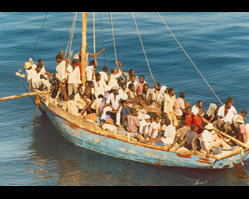The image above is of a group of Haitian refugees who are making their way toward Cuba. This image reveals the terrible conditions of the boats and journey the Haitian people endured during their travels. The over-crowding of people shows how many individuals searched and dreamed of freedom to the west. By Antoinette Strickland In…
Read moreGuantánamo Public Memory Project
Tag: Cuban Balseros
This Week in Guantánamo: 2012 and 1916
This Week in Guantánamo: Present and Past

Two Guantánamo detainees from China, who were held for more than 10 years without charges, have been resettled in El Salvador. Both were captured in Pakistan along with 20 other Uighurs—a Muslim group who live primarily in China’s Xinjiang Uyghur Autonomous Region, and have had recent troubles with the Chinese government. These men were in…
Read moreLocating in Obscurity: Cuba and Guantánamo Bay
National Dialogue and Traveling Exhibit

Present day Guantánamo Bay is a space that exists in obscurity, both in terms of geography and public imagination. Locating it on a map might involve a simple rendering of the Caribbean islands or, specifically, the southeastern region of Cuba; but to identify the space as a land once colonized by Spain where native Cubans…
Read moreReflection: The American Dream in Action
National Dialogue and Traveling Exhibit | Reflection + Action
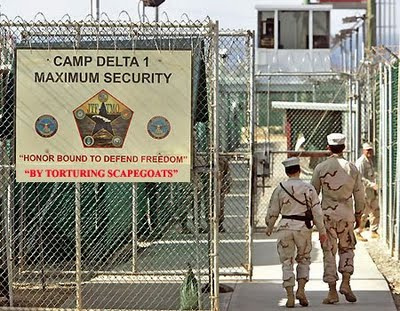
After reading all of the articles provided at the Guantánamo Public Memory Project website, seeing all the images and hearing all of the testimonies, I feel so entrenched in the site and its situation that I want to take the next personnel flight back stateside. Just like many others who visit, part of me remains…
Read moreReflection: Ambiguity in Memories of Guantánamo Bay
National Dialogue and Traveling Exhibit
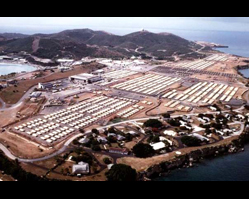
The story from our short study of Guantánamo Bay’s history that I found the most compelling is Janet Miller’s narrative in Memories of Guantánamo Bay, 1960-1962. What I find so striking is how incongruent her experience at the base is with my prior understanding of Guantánamo. How can a place that has witnessed so…
Read moreOccupation Justification: Freedom, Control, and the Paradox of Guantánamo
National Dialogue and Traveling Exhibit
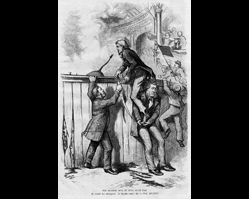
“If we know Saddam Hussein has dangerous weapons today – and we do – does it make any sense for the world to wait to confront him as he grows even stronger and develops even more dangerous weapons?” “America is a friend to the people of Iraq. Our demands are directed only at…
Read moreHIV-positive Haitians at Guantánamo Bay
National Dialogue and Traveling Exhibit
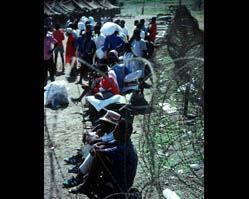
In the early 1990s, with the arrival of thousands of Haitian immigrants, Guantánamo Bay served as one of the first sites of mass HIV testing for immigrants. Over 260 individuals tested positive and were segregated in Camp Bulkeley, a tent camp surrounded by barbed wire. Haitians reported limited mobility, poor sanitation, and insufficient and…
Read moreReflection: Guantánamo Bay – Collective Confusion and Misinformation
National Dialogue and Traveling Exhibit | Reflection + Action

While learning the history of the Guantánamo Naval base (GTMO), time and time again I’ve been struck by a sense of collective confusion and misinformation that has reappeared in the stories of people stationed at the base, as well as detainees and non-American workers who have lived there. The base has often been used…
Read moreThis Week in Guantánamo: 1993 and 2012
This Week in Guantánamo: Present and Past
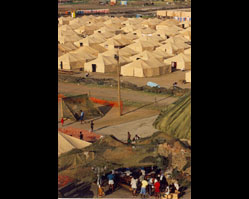
2012: This week, the Pentagon set Khalid Sheik Mohammed’s long awaited trial in motion. He and four other Guantánamo Bay detainees, accused of orchestrating the September 11, 2001 attacks, will be tried at a military tribunal instead of a civilian court. They face the death penalty if convicted. These five men are charged with organizing…
Read moreCuban Commuters
National Dialogue and Traveling Exhibit
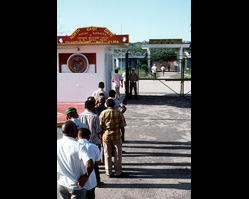
The role of Cuban workers on the Guantánamo Bay naval base has fluctuated over time. Those who work on the base, but return to homes in Cuba are referred to as “commuters.” In the 1950s, according to historian Jonathan Hansen, there were as many as 3,000 commuters. However, as the Cold War progressed…
Read moreCreative: Picture Projects & Tronvig Group

